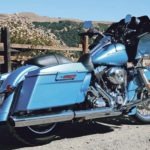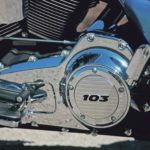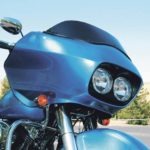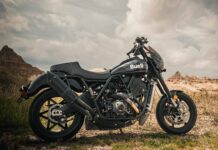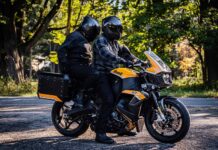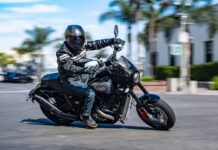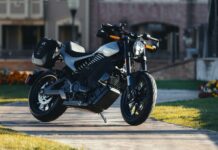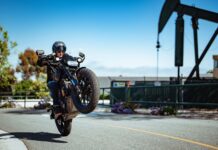Riding a blue streak
Low down and loaded up
The fun begins a few miles west of the town of Williams when Highway 20 leaves the flat terrain of the Sacramento Valley and commences to corkscrew through the foothills of the Mayacamas Mountains. Here the Road Glide Custom is in its element, swooping effortlessly through the sweepers, up and down the grades, the torque-rich TC 103 mill surging eagerly up the inclines with shifting virtually optional, and the sensation is that of piloting an open cockpit fighter on a long strafing run—a sensation heightened by the one-with-the-machine operator position and the bike’s chopped fairing which serves more as a nosecone than a wind stopper. The machine is pleasingly nimble, displaying tautly predictable and unflappable manners, and providing generous cornering clearance—it takes real conviction to ground a footboard on this thing. No apex is safe from the Blue Streak, as I’ve come to call it, and neither for that matter are the banzai ground squirrels. I have the kill marks to prove it.
This particular FLTRX is loaded up with factory options, including cruise control, Chrome Profile laced wheels and, especially, the PowerPak. The PowerPak is a $1,995 suite of upgrades consisting of an anti-lock braking system, Smart Security System and the aforementioned TC 103 motor in place of the standard TC 96. With its wider bore and higher compression ratio, the TC 103 brings a lusty 102 ft/lbs of torque to the game, and it asks little in return. Fuel economy is at least comparable to the TC 96 (we averaged a surprising 46.8 mpg in highway use on the machine), and any additional heat generated by the greater compression is handled effectively by the oil cooler mounted subtly below the voltage regulator and looking like a demi-chin spoiler.
Add to that the most excellent ABS that was first offered on the Touring models for 2008, and you’ve already more than justified the PowerPak upcharge. This system pairs with the stock Brembo brakes to provide superb stopping capability in even the most dicey situations, be it rain-soaked pavement, a gravel spill or a drifting texter. Considering how perilous traffic has become these days, especially in over-trafficked urban areas, we can’t recommend this system too highly. (And we’re happy to report that it’s offered on Softail models for the first time this year. We’ll be reviewing that development in the near future.)
We can’t really tell you much about the Smart Security System on this bike since the moto-press corps isn’t smart enough to figure them out, and Harley finally realized that handing us the Smart key fob was like handing a slide rule to a chimp, and they’re no longer used on test fleet models. Suits us. (If we had our way, the PowerPak bundle would consist of the TC 103, ABS, and cruise control instead of Smart Security. We’re just sayin’…)
Provenance
The Road Glide Custom is an odd duck in the Milwaukee pond and raised eyebrows when introduced last year as the only representative of the Road Glide clan. There are two reasons for that, really, the first being the absence of an actual Road Glide—the purpose-built two-up distance tourer that had garnered its own devoted following over the years, largely on the aesthetics and handling appeal of its frame-mounted, dual-headlamp fairing, fondly referred to as the shark nose. There was alarm at the time that that model was history, and also consternation at the Custom that seemingly replaced it, being essentially an FLHX Street Glide with its batwing fairing swapped for the shark nose sans functional windscreen that had appeared on the 2009 CVO Road Glide.
As it turned out, Milwaukee hadn’t planned it that way, and had originally intended to roll out the grand new Road Glide Ultra for 2010, but that cake wasn’t fully baked until this year. Knowing that now, the creation of the Custom makes a whole lot more sense, as the custom bagger genre has come to embrace the shark nose enthusiastically, and it was a shrewd and simple move for the designers to bolt one on to their existing haute-custom bagger, the Street Glide—and it didn’t hurt, in making that decision, that the Street Glide also happened to be the biggest-selling street bike of any make in the U.S.
In light of that consanguinity between the FLHX and FLTRX, the Motor Company coined the obvious term “hot rod bagger” to apply to those two models, though we’ve taken to calling them the “X-Glides” for equally obvious reasons. Theyshared the pitch-perfect custom touches of a rear suspension slammed by an inch and a rear fender with side panel fillers and the tri-band array of frenched-in tail lighting. They also shared color-matched saddlebag latches, an 18-inch low-profile front tire, passenger footpegs rather than footboards and, at the time, a 2-into-1 exhaust system that eliminated the left-side muffler. Changes to both models for 2011 include a new seat that’s narrower in the front for easier leg stretch to the pavement, and a retrenchment to the familiar 2-1-2 exhaust. Uncharacteristically, Harley listened to customer complaints about the 2-into-1 setup—specifically that they didn’t fancy the asymmetry and it was too costly to add a second muffler—and made the change. (From our humble perspective, they should have ignored the whining, for reasons both functional and aural.)
What the X-Glides share in common above all else this year, though, is the availability of the PowerPak as an option, and in practice that option expands the sub-platform to four distinct models. It also presents a strange Touring model landscape wherein the TC 103 is standard on the Road King Classic, Electra Glide Ultra Classic Limited and Road Glide Ultra, optional on the X-Glides, but unavailable on the standard Road King, Electra Glide Classic or Ultra Classic. If that seems confusing, it’s because it is.
Quick fix
It’s out on the Interstate during long fast stretches of serious mile pounding that the Road Glide Custom’s lack of a windscreen of any consequence—its Faustian deal with custom chic—knocks some of the model’s luster off. Under those circumstances, the dark eyebrow extending barely to the top of the stereo deck serves only to direct the wind gathered by the shark nose right into your face. It’s not so much a buffeting as a full-on blow, and besides that annoyance there’s the annoyance of the 40-watt Harman/Kardon sound system being rendered virtually inaudible by wind noise at even moderate speeds. But so what? You know that going in with this bike, and the fix is easy enough. Get a taller windscreen to slap on for road trips. The swap is an easy five-minute operation, and a smoked 12″ Wind Splitter Windshield from H-D P&A should do the trick for about $160. It’s always nice to have options.


